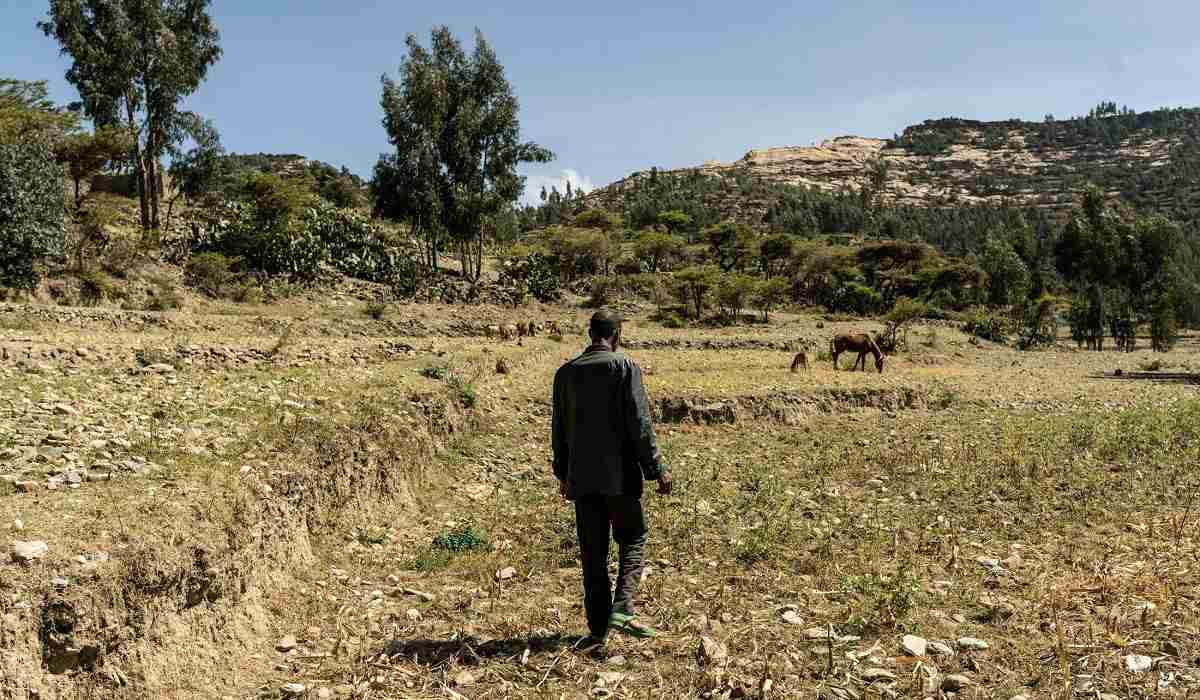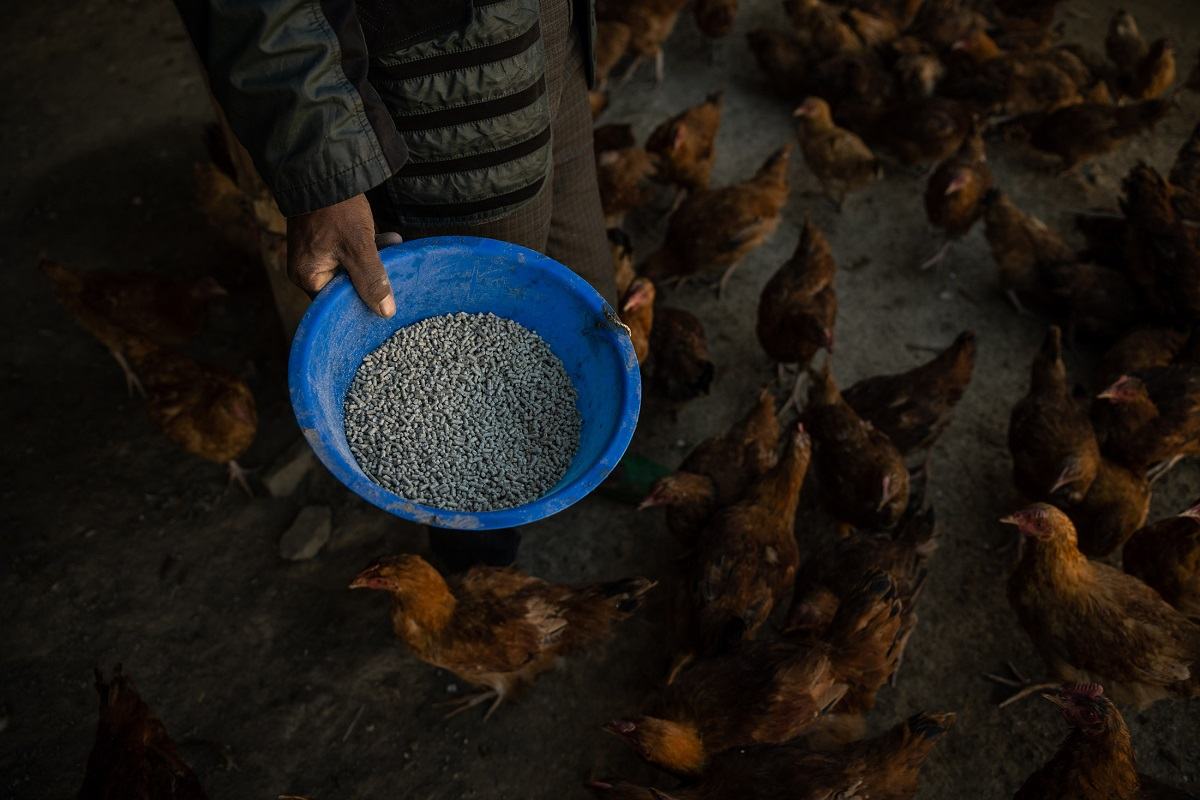
Farmer Alem Garad walks in his drought-destroyed fields on Nov. 2, 2023, near his home in Atsbi in Ethiopia’s Tigray region.
15:31 JST, December 3, 2023
ADDIS ABABA, Ethiopia – Scientists, government officials and farmers are reviving neglected crops and boosting agricultural productivity in a race to cushion Africa from growing food shortages exacerbated by climate change. But only a trickle of donor funds and almost no private capital are directed to the small farmers who produce the vast majority of the continent’s food.
Rising temperatures mean large chunks of Africa are whipsawing between increasingly severe droughts and more frequent and intense cyclones, threatening staple foods for hundreds of millions of people. The International Monetary Fund says each increase of 1 degree Celsius correlates to a 3 percent reduction in agricultural output in developing countries. It forecasts crop yields in sub-Saharan Africa will decline by 5 to 17 percent by 2050, despite a rapidly growing population. Smallholder farmers are already struggling.
Increasing the notoriously low yields from African livestock and crops is one of the easiest ways to cut down on emissions, protect wildlife habitat and help farmers, said Enock Chikava, interim director of agricultural development at the Bill and Melinda Gates Foundation.
But only 1.7 percent of global climate finance goes to projects with smallholder farmers, who produce around 80 percent of food in Africa and Asia. While wealthy nations have met a pledge to provide $100 billion annually to help developing countries achieve climate goals, African leaders meeting at COP28 in Dubai say they want funding for farmers to be vastly increased.
“Change can only come with capital from the private sector,” said Amath Pathé Sene, head of the Africa Food Systems Forum.
So far, that’s elusive. Unclear pricing and regulation and confusion over what is defined as a “climate solution” have kept most big investors away from climate adaptation in Africa, he said.
The Climate Policy Initiative, which tracks global climate financing, says more than 95 percent of funding goes into projects focused on renewable energy, low-carbon transportation and energy efficiency.
EthioChicken, set up in 2010 by three Americans in their mid-20s, is an exception – a private company that helps blunt the effects of climate change for smallholder farmers but still makes a profit. Chickens produce a fraction of the methane emissions of goats and cows and need far less water. Diversifying to high-yield chickens means farmers can hedge against crop failure with a cash stream that is also low carbon.
The company’s clients are people like Ethiopian farmer Alem Garad. Normally, his wheat should be as high as his 10-year-old son, but this year a localized drought means the stunted sheaves are animal feed. Baby goats munch on the withered stalks. Yet the family is not hungry. Around 80 fat Sasso chickens squawk and scratch in his stone henhouse. EthioChicken imported the French breed for its hardiness, foraging ability and high egg production.
Alem says the “ferengi,” or foreign, chickens lay about three times as much as his local “habesha,” or native highland, chickens. His wife has enough eggs left over after feeding their family of six to sell and buy grain. Birds sold for meat fetch double the price of a normal chicken, but it’s their high egg yield that makes them most popular.
“If we didn’t have these chickens during the drought, we’d be very hopeless,” he said, a well-fed toddler clinging to his shin and giggling. “They provide what the crops would have.”

Alem Garad feeds his hens on Nov. 2, 2023, in front of his coop, in Atsbi, in Ethiopia’s Tigray region.
The founders of EthioChicken, set up 13 years ago, hawked their first crop of chicks out of baskets strapped to motorbikes when a contract fell through. But now the company employs 1,600 people directly and 10,000 agents, and has been boosted by investments from the World Bank’s private arm, the International Finance Corp.; and the Gates Foundation. The company projects it will sell 35 million chicks this year and has expanded to five other countries under the umbrella Hatch Africa.
Yet for now, climate disaster is outpacing innovation. The U.N. World Food Program says 170 million people in sub-Saharan Africa face severe hunger this year.
East Africa has just suffered its worst drought in 40 years, and its sunbaked soils are now deluged by the worst flooding in a century. Of Africa’s 30 deadliest climate events ever, six have taken place in the past two years, Yale Climate Connections has found.
More delicate crops such as wheat, rice and maize often fail under these conditions. Even hardier, traditional crops such as millet and cassava need to be bred into tougher strains, said Chiedozie Egesi, project director of the Next Generation Cassava Breeding Project and adjunct professor of plant breeding and genetics at Cornell University.
In Nigeria, farmers in two states are conducting trials of new forms of cassava – a staple crop for 300 million people. The chunky roots are far more drought resistant than other staples, but intense cyclones and higher temperatures leave them vulnerable to rotting and pests. Yet there’s little funding or interest in cassava – not commonly consumed outside the continent – while the African Development Bank has set aside $1 billion to boost production of far less hardy wheat.
Other projects are underway: insurance for payouts, linked to NASA weather data, for livestock farmers; tailored weather alerts for farmers sent via mobile phones; and renewed interest in neglected but hardy crops. The Consultative Group on International Agricultural Research (CGIAR), a global innovation network, is setting up gene banks and crossbreeding more productive strains from traditional dryland crops like sorghum, millet and pigeon peas.
But time may be running short. Extreme weather often feeds conflict, as people fight over water, arable land and grazing, or join armed groups for survival or access to food, said Hameed Nuru, director of the World Food Program’s African Union office.
Hunger also fuels political instability, as populations reeling under inflation and starvation rally to demand change. In a world that is 2 degrees Celsius warmer, an additional 189 million people will be hungry, CGIAR says. At 4 degrees warmer, that will be 1.8 billion. Global temperatures broke the 2-degree barrier for the first time in November.
“We live in desperate times and need desperate, urgent, immediate measures,” Nuru said. “The time is now. Tomorrow cannot wait.”
"News Services" POPULAR ARTICLE
-

American Playwright Jeremy O. Harris Arrested in Japan on Alleged Drug Smuggling
-

Japan’s Nikkei Stock Average as JGB Yields, Yen Rise on Rate-Hike Bets
-

Japan’s Nikkei Stock Average Licks Wounds after Selloff Sparked by BOJ Hike Bets (UPDATE 1)
-

Japanese Bond Yields Zoom, Stocks Slide as Rate Hike Looms
-

Japan’s Nikkei Stock Average Buoyed by Stable Yen; SoftBank’s Slide Caps Gains (UPDATE 1)
JN ACCESS RANKING
-

Keidanren Chairman Yoshinobu Tsutsui Visits Kashiwazaki-Kariwa Nuclear Power Plant; Inspects New Emergency Safety System
-

Imports of Rare Earths from China Facing Delays, May Be Caused by Deterioration of Japan-China Relations
-

University of Tokyo Professor Discusses Japanese Economic Security in Interview Ahead of Forum
-

Japan Pulls out of Vietnam Nuclear Project, Complicating Hanoi’s Power Plans
-

Govt Aims to Expand NISA Program Lineup, Abolish Age Restriction



















